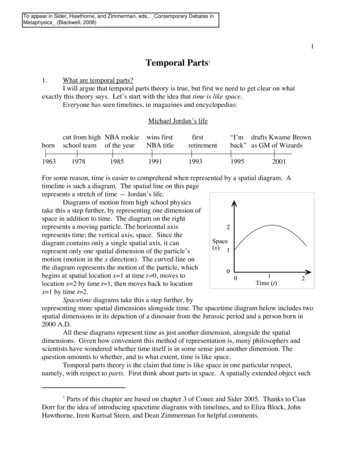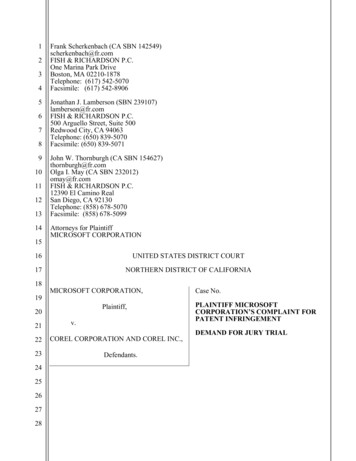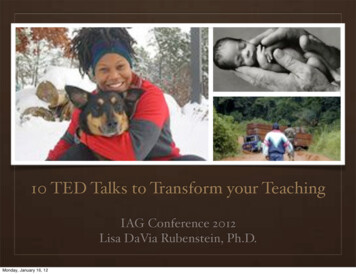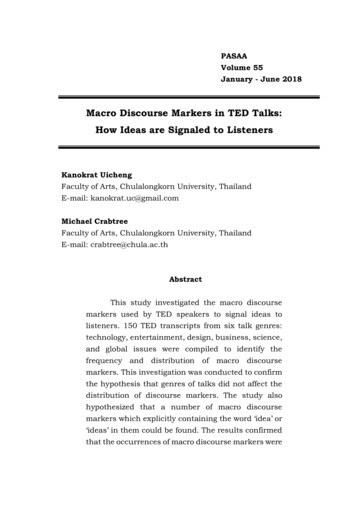
Transcription
To appear in Sider, Hawthorne, and Zimmerman, eds., Contemporary Debates inMetaphysics (Blackwell, 2008)1Temporal Parts11.What are temporal parts?I will argue that temporal parts theory is true, but first we need to get clear on whatexactly this theory says. Let’s start with the idea that time is like space.Everyone has seen timelines, in magazines and encyclopedias:Michael Jordan’s lifeborncut from high NBA rookieschool team of the yearwins firstNBA titlefirstretirement“I’m drafts Kwame Brownback” as GM of r some reason, time is easier to comprehend when represented by a spatial diagram. Atimeline is such a diagram. The spatial line on this pagerepresents a stretch of time — Jordan’s life.Diagrams of motion from high school physicstake this a step further, by representing one dimension ofspace in addition to time. The diagram on the rightrepresents a moving particle. The horizontal axisrepresents time; the vertical axis, space. Since thediagram contains only a single spatial axis, it canrepresent only one spatial dimension of the particle’smotion (motion in the x direction). The curved line onthe diagram represents the motion of the particle, whichbegins at spatial location x 1 at time t 0, moves tolocation x 2 by time t 1, then moves back to locationx 1 by time t 2.Spacetime diagrams take this a step further, byrepresenting more spatial dimensions alongside time. The spacetime diagram below includes twospatial dimensions in its depiction of a dinosaur from the Jurassic period and a person born in2000 A.D.All these diagrams represent time as just another dimension, alongside the spatialdimensions. Given how convenient this method of representation is, many philosophers andscientists have wondered whether time itself is in some sense just another dimension. Thequestion amounts to whether, and to what extent, time is like space.Temporal parts theory is the claim that time is like space in one particular respect,namely, with respect to parts. First think about parts in space. A spatially extended object such1Parts of this chapter are based on chapter 3 of Conee and Sider 2005. Thanks to CianDorr for the idea of introducing spacetime diagrams with timelines, and to Eliza Block, JohnHawthorne, Irem Kurtsal Steen, and Dean Zimmerman for helpful comments.
2as a person has spatial parts: herhead, arms, etc. Likewise,according to temporal parts theory,a temporally extended object hastemporal parts. Following theanalogy, since spatial parts aresmaller than the whole object inspatial dimensions, temporal partsare smaller than the whole object inthe temporal dimension. They areshorter-lived. The spacetimediagram makes this clear. Thewhole person is the followingSpace-Time Diagramobject:. He isspread out from left to right because he lasts over time; he begins to exist in 2000 A.D., and lastsfor a number of years beyond that. The parts of the diagram, ,and, represent some ofhis temporal parts.A person’s temporal part at a time is exactly the same, spatially, as the person at thattime, but it exists only for a moment. Thus, the early temporal part looks, feels and smells likea baby, but it lasts only for an instant. If you watch the baby for awhile, you will first be lookingat one temporal part, then another much like it, then another much like the last one, and so on. Ifyou watch long enough, you will notice that the later temporal parts are slightly bigger than theearlier ones. This is because the baby is growing. Accordingly, the leftmost temporal partsrepresented on the diagram are smaller than the rightmost temporal parts. For comparison,imagine looking at a person’s wrist. Now move your gaze slowly up the person’s arm, towardthe shoulder. The arm in your field of vision “grows”, from wrist size to shoulder size, sinceyour eyes pass over different spatial parts of the person, first smaller parts (the wrist), then largerparts (the shoulder).Temporal parts have spatial parts, and spatial parts have temporal parts. Consider thehead of the person in the diagram:. This representation of the headextends from left to right because heads, like persons, last over time. The head — a spatial partof the person — thus has temporal parts: , and . Like the person, the head grows; itsearlier temporal parts are smaller than its later ones. Now, consider one of these temporal partsof the head, the last one for example:. It is part of the last pictured temporal part of theperson:. In fact, it is a spatial part of this temporal part of the person. (Notice that the verysame object, namely, is both a temporal part of a spatial part and also a spatial part of a
3temporal part.)The existence of temporal parts is just one way that I believe time to be like space. Hereare two others (the nature of time is discussed more fully in chapter 5). 1. Time is like spaceregarding the reality of distant objects. Spatially distant objects, such as objects on Mars, arejust as real as objects here on Earth. The fact that Mars is far away doesn’t make it any less real;it just makes it harder to learn facts about it (we need a telescope). Likewise, I think, temporallydistant objects, such as dinosaurs, are just as real as objects we experience now. The fact that adinosaur is far away in time doesn’t make it any less real; it just makes it harder to learn factsabout it (we need to examine fossils). The belief that temporally distant objects are real issometimes called “eternalism”. (The main opposing view, “presentism”, says that only objectsin the present time exist.) 2. Time is like space regarding the relativity of here and now. Whenspeaking to my brother in Chicago, if I say “here it is sunny” and he says “here it is raining”, wedo not really disagree. What is called “here” changes depending on who is speaking: I meanNew Jersey, he means Chicago. There is no one true here. I think that the word ‘now’ worksanalogously. Imagine the dinosaur in the spacetime diagram above saying “It is now the JurassicPeriod”. I, on the other hand, say “It is now 2006”. According to the relativity of ‘now’, thedinosaur and I do not really disagree. There is no one true now. What is called “now” changesdepending on who is speaking: I mean 2006, the dinosaur means the Jurassic Period. Thecombination of this theory of the function of ‘now’ and eternalism is often called the “B-theoryof time”.It is important to distinguish between the different facets of the space-time analogy, sincesome philosophers accept some facets while rejecting others.2 Some accept the B-theory whiledenying the existence of temporal parts; and some embrace temporal parts while denying thattime is like space in one or more ways. What I will defend here, however, is the “B-theory”version of temporal parts theory.So: is temporal parts theory true? Do temporal parts really exist — do persons and otherphysical objects really have parts that last only for an instant? Temporal parts theory is a verygeneral and speculative theory about the world, about what objects exist and what they are like.It is speculative because the question of its truth is hard to settle by observation or experiment.3Crudely put, objects look the same, whether or not they are made of temporal parts. Experimentand observation would be unnecessary if all rival theories were internally inconsistent; then wecould deduce temporal parts theory from pure logic alone. Unfortunately this is not the case;there are internally consistent opposing theories.2The task of keeping the facets clearly distinguished is made more difficult by badlychosen terminology: some philosophers use the term ‘four-dimensionalism’ for the doctrine oftemporal parts alone, even though the term suggests the stronger claim that time and space areanalogous in more ways. Another (better) bit of jargon is the following. To say that objectsperdure is to say that they have temporal parts; to say that objects endure is to say that they donot have temporal parts.3I do not say “impossible to settle”; science sometimes bears on metaphysical questionsin unforeseen ways.
4We cannot prove temporal parts theory, but never fear! I believe that assessing thephilosophical case for temporal parts allows one to make a decent educated guess. I willconsider the following arguments for temporal parts: i) the problem of change, ii) the paradoxesof material constitution, and iii) the argument from vagueness and anthropocentrism.2.Change and temporary intrinsicsThe oldest argument for temporal parts starts with the mundane fact that things change.Suppose that I am first standing, so that I am straight-shaped. Then I sit down, so I am bentshaped. The standing person, call him Ted1, seems to have different properties from the sittingperson, call him Ted2; only Ted1 has the property being straight-shaped. But everyone agreesthat Leibniz’s Law is correct:Leibniz’s Law:Objects x and y are identical only if they have exactly the sameproperties.For if x and y are identical, then when we talk about x and y, we are talking about a single object,in which case it makes no sense to say that x has different properties from y. Leibniz’s Lawseems to tell us that Ted1 and Ted2 are not identical, since they have different properties. So, theargument concludes, Ted1 and Ted2 are distinct temporal parts of me.This is a bad argument. Its flaw can be seen byviewing the situation from the perspective of aspacetime diagram. A spacetime diagram depicts theentirety of an object all at once. It is as if we take theperspective of God and look in on time from theoutside; we take the “timeless perspective” on reality.From the timeless perspective, what properties do I —in my entirety — have? What am I like? The argumentabove spoke of properties such as “being straightshaped” and “being bent-shaped”, but in light of thespacetime diagram, it isn’t right to describe me assimply being straight-shaped or as simply being bentshaped, since I am straight-shaped at some times andbent-shaped at others. From the timeless perspective, it makes no sense to speak of propertieslike “being straight-shaped”. Instead, we must speak of my shape at various times. Here, then,are the properties that I have from the timeless perspective:(P)being straight-shaped at time t1being straight-shaped at time t2being bent-shaped at time t3being bent-shaped at time t4Moreover, both Ted1 and Ted2 have all the properties (P), for Ted1 and Ted2 are the very sameobject, namely, the person depicted in the diagram! The names ‘Ted1’ and ‘Ted2’ wereintroduced as names for “the standing person” and “the sitting person”, respectively. But the
5standing person and the sitting person are the very same person, namely, the person depicted inthe diagram; namely, me. I am a person who was straight-shaped at times t1 and t2, and who wasbent-shaped at times t3 and t4. So the argument goes wrong when it claims that Ted1 and Ted2have different properties.The argument fails. But some people think that further reflection on the subject ofchange leads to a new argument for temporal parts. Let’s look more closely at the reply to theargument from change that was given in the previous paragraph.The crucial move came when I said that the properties an object has are those it has fromthe timeless perspective. These properties, as we saw, are properties like being straight-shapedat time t1. Call these indexed properties, since they involving “indexing” (or “relativizing”)temporary properties (in this case, being straight-shaped) to times (in this case, t1). Now, inaddition to making the crucial move of saying that objects have indexed properties, a temporalparts theorist will want to go one step further, and say something about what having indexedproperties amounts to. He will want to give the following temporal-parts theory of (at leastsome) indexed properties: a person is straight-shaped at time t1 because that person’s temporalpart at t1 is straight-shaped, period. A temporal part, unlike a continuing person, can be said to“have a straight shape, period” (as opposed to having a straight shape at one time or another),because a temporal part exists at only a single time. Temporal parts, unlike continuing objects,can have non-indexed properties.An opponent of temporal parts, on the other hand, cannot take this further step, since thefurther step assumes that temporal parts exist. She will instead stop with the claim that Ted1 andTed2 have the indexed properties (P); she will not go on to say that objects have indexedproperties because of temporal parts with non-indexed properties.4 For her, properties like shapeare fundamentally indexedNow for the new argument from change for temporal parts, put forward by David Lewis(1986, pp. 202-204). The new argument is in essence a complaint against fundamentally indexedproperties. According to Lewis, certain properties — including shape properties — must beexplained in terms of non-indexed properties:[According to the indexer,] shapes are not genuine intrinsic properties. They are disguisedrelations, which an enduring thing may bear to times. One and the same enduring thing may bearthe bent-shape relation to some times, and the straight-shape relation to others. In itself,considered apart from its relations to other things, it has no shape at all. . . This is simplyincredible. . . If we know what shape is, we know that it is a property, not a relation. (Lewis 1986,p. 204)If fundamental indexing is no good, then shape properties must be explained in terms of nonindexed properties of temporal parts. Therefore, Lewis concluded, temporal parts must exist.This argument for temporal parts is known as the argument from temporary intrinsics.Lewis’s argument has been discussed extensively, especially his reason for claiming that4A complication: certain opponents of the B-theory can make a different reply to theargument from change than I made above, and so never need to appeal to indexed properties, andso escape Lewis’s argument. See Zimmerman 2006.
6shape properties must be explained in terms of non-indexed properties. Why is he so sure that“If we know what shape is, we know that it is a property, not a relation”? On one way of readingLewis, the reason is that properties like shape are intrinsic. Intrinsic properties are those that arehad by an object just in virtue of the way that object is, regardless of what other objects are like.Shapes are, Lewis thinks, paradigm examples. Extrinsic properties, on the other hand, dependon what other objects are like. Being an uncle is a paradigm example: whether you are an uncleconstitutively depends not just on you, but also on other people; namely, on whether you have aniece or nephew. That is, it depends on whether you bear the is an uncle of relation to someone.(Extrinsic properties are sometimes called “relational”.) Now, if shapes are indexed, so theargument goes, then shapes become just as extrinsic as being an uncle, for I have the propertiesin (P) in virtue of being related to other objects. Which other objects? Times. I have theproperty being straight-shaped at time t1, for example, in virtue of bearing the is bent-shaped atrelation to the time t1.This reason is not very convincing. Even if all properties turn out extrinsic in a sense,there may yet be an important difference between properties like shapes and properties like beingan uncle. Only properties like the latter involve other particular objects, as opposed to times.5Lewis might instead appeal to a fairly abstract metaphysical intuition. Late in the 19thcentury, British idealists like F. H. Bradley claimed that the world is a single interconnectedwhole. According to Bradley, to describe a single object, for instance a certain eight-ball, onemust bring the entire world into the description. In addition to saying that the eight-ball is black,has a certain mass, and so on, one must also mention the eight-ball’s distance from the cue ball.Not only that; one must also mention what is going on in the house next door, occurrences inother countries and other times . . . All these facts pertain equally to the eight-ball. We cannotseparate the facts about the eight-ball into the facts about the eight-ball’s intrinsic features andthe facts about its relations to other things. Subsequent philosophers, notably G. E. Moore andBertrand Russell, rejected this view emphatically. Against Bradley’s holism, Moore and Russelladvanced an opposing picture of a world of many separate little bits. Each bit can be describedintrinsically without bringing in the rest. There are, of course, relations between the bits. Adescription of the world that characterizes the eight-ball perfectly, down to the last detail, andlikewise for the cue ball, is not complete until it specifies the distance relation holding betweenthe balls. Moore and Russell’s complaint was not that Bradley accepted relational facts, for theyaccepted them too. It was rather that Bradley did away with intrinsic properties.6Lewis’s complaint about indexing is like Moore and Russell’s complaint about Bradley.The indexer claims that all of reality is relational. No object is just plain straight, or just plainblack, or just plain 50 grams. Objects are straight, black, or 50 grams, with respect to, or relativeto, other objects (times). That, Lewis says, is implausible.There may be something to this complaint, but it is nowhere near as forceful as Mooreand Russell’s complaint against Bradley, for the indexer’s world is nowhere near as holistic asBradley’s. An indexer is free to agree that the eight-ball can be completely described without5See Haslanger 1989.6This is merely a caricature; see Hylton 1990 for a historically responsible discussion.
7bringing in the cue ball, let alone the house next door. The description must indeed bring in atime, but that is all.Lewis’s argument that shape properties are not indexed to times is based on the brutemetaphysical intuition that shape doesn’t work that way. Shapes are instantiated, period (notrelative to a time); at the most fundamental level they are Moorean/Russellian non-relationalproperties. Unfortunately, Lewis’s opponent is likely to flatly reject the alleged intuition. Ofcourse, the fact that an opponent can reject the premises of an argument doesn’t on its own showthat the argument is no good, for it may be irrational to reject the premises. But in this case, it ishard to convict Lewis’s opponent of irrationality. It is unclear how powerful Lewis’smetaphysical intuition is.3.The paradoxes of material constitutionLet us consider next a number of fascinating puzzles known collectively as the paradoxesof material constitution. Each consists of an argument for the apparently outrageous conclusionthat two distinct objects can be made up of, or constituted by, the same matter. Call thisconclusion “cohabitation”, for it says that the same matter can be “inhabited” by two objects.The philosophical task is to say where the flaw in the argument lies, or, alternatively, to say whycohabitation is not as outrageous as it appears. Either approach requires developing a generaltheory of the nature of material objects. The argument for temporal parts lurking here is that thebest approach to the paradoxes appeals to temporal parts. To show that this approach is the best,we must examine alternate approaches; that is the plan for this section and sections 3.1-3.5.The paradoxes come in many forms. I will consider two: the statue and the clay, andundetached parts.The statue and the clay: a sculptor begins on Monday with an unformed piece of clay,which she shapes on Tuesday into the form of a statue. We now argue as follows:P1:P2:P3:C:The piece of clay that existed Monday continues to exist on Tuesday after beinggiven statue shapeThe sculptor creates a statue, which exists on Tuesday but not on MondayIf P1 and P2 are correct, then the statue and the piece of clay are two differentmaterial objects that on Tuesday are made up of exactly the same matter. Theyare not the same object because of Leibniz’s Law: the piece of clay, but not thestatue, exists on Monday.Therefore, different material objects can be made up of the same matter at a singletimeThe argument is logically valid, and its premises seem correct, yet its conclusion seems false.That is the paradox.Suppose the sculptor tires of the statue on Wednesday, and squashes it, seeminglydestroying it. We can then form a parallel argument for the same conclusion:P1 :P2 :The piece of clay that composes the statue on Tuesday is not destroyed when it issquashed, so it continues to exist after WednesdayThe statue that exists on Tuesday is destroyed when it is squashed, and so does
8P3 :C:not exist after WednesdayIf P1 and P2 are correct, then the statue and the piece of clay are two differentmaterial objects that on Tuesday are made up of exactly the same matter. Theyare not the same object because of Leibniz’s Law: the piece of clay, but not thestatue, exists after WednesdayTherefore, different material objects can be made up of the same matter at a singletimeUndetached parts: in addition to its tail, legs, head, and so on, a cat also has larger parts,for instance its torso: all of the cat except for the tail. Consider now a certain cat, Tibbles, andits torso, Tib. Unfortunately for Tibbles, on Tuesday its tail is chopped off and the tail’s matteris destroyed. We now argue as follows:P4:P5:P6:C:Tibbles exists on Tuesday, since a cat can survive the destruction of its tailTib exists on Tuesday, since chopping off the tail did not affect Tib at all; itmerely removed an external object that was once attached to TibIf P4 and P5 are correct, then on Tuesday, Tibbles and Tib are two differentmaterial objects made of the same matter. They are not the same object becauseof Leibniz’s Law: Tibbles, but not Tib, had a tail as a part before TuesdayTherefore, different material objects can be made up of the same matter at a singletimeAgain, the argument’s premises seem correct, yet its conclusion seems false.To get an intuitive handle on what is going on with these arguments, the concept of“tracing” is helpful. Suppose you are given the task of tracing a certain object through time.This, you are told, means ascertaining where this very object has been in the past, and where itwill be in the future. What information will you need to accomplish the task?One thing you will need to know is what sort of thing your object is. We ordinarily thinkof the world as involving objects of various sorts: pieces of clay, statues, cats, and so on. Theseobjects persist over time, through various changes. Cats age; pieces of clay change their shape.But a cat or a piece of clay cannot survive just any change: some changes destroy a thing.Dismembering a cat destroys it; we do not think of the resultant body parts as being the sameobject as the cat. Furthermore, other changes create a new thing. Sculpting a piece of clay, weordinarily think, creates a statue. Finally — and here is the crucial bit — whether a givenchange destroys a thing, or creates a new thing, depends on what sort of object that thing is.Sculpting the clay creates a statue; it does not create a new piece of clay. Being squashed flatdestroys a statue but not a piece of clay. At least, that is what we ordinarily think. So, sincetracing an object requires ascertaining when it was created, and which changes it survives (sincewe must ascertain whether the very same object is present at different times) tracing an objectrequires knowing what sort of thing it is.The paradoxes of constitution are based on this fact, that different sorts of objects areassociated with different criteria for tracing. Each argument shows that two paths of tracing canintersect at a location that appears to contain only a single object. In the statue/clay case, forinstance, piece of clay tracing begins before Monday, leads to the clay in statue form on
9Tuesday, then extends beyond Wednesday to the clay in squashed form. Statue tracing has adifferent starting point: it begins on Tuesday when the sculptor’s work is done, but also leads tothe clay in statue form; it then ends on Wednesday when the statue is squashed. Our ordinarybeliefs associate an object with each way of tracing, and so lead to two objects made up onTuesday of the same clay, at the point where the paths of tracing intersect.We have, then, three arguments for the apparently absurd conclusion of cohabitation.The challenge is to find a reason to think that cohabitation is not as outrageous as it seems, or areason to reject a premise from each argument. Either sort of reason requires articulating ageneral theory of material objects. As we will see at the end, temporal parts theory is one suchtheory, but first let us examine some rivals.3.1The constitution viewOne of the most popular responses to the arguments is simply to accept cohabitation.This response has the advantage of taking all of our beliefs about tracing seriously. We want totrace pieces of clay as well as statues, and torsos as well as cats. As the arguments show, thisleads to admitting the possibility of two different objects sharing exactly the same matter. Theconstitution view simply embraces this conclusion (without admitting the existence of temporalparts).Since the statue and the piece of clay share the same matter, they are extremely similar.Obviously, the piece of clay is exactly the same mass, shape, size, and smell as the statue. Now,a perfect replica of a statue, made by a master forger, would also share these qualities. But thepiece of clay is far more similar to the statue, for it is made of the very same matter. It is inexactly the same place as the statue. How, then, can it be a different object?Defenders of the constitution view say that the statue and the piece of clay can bedifferent objects despite being so similar because each is constituted by the same matter.Constitution is the relationship that holds between a thing and the quantity of matter that makesit up. But speaking of “constitution” does not explain how cohabitation is possible; it merelyplaces a label on a problem.And there is indeed a problem. Let me mention two arguments that have been putforward against the constitution view. First: according to the constitution view, squashing thestatue destroys the statue, but does not destroy the piece of clay from which it is made. Thus, thestatue is vulnerable to destruction in a way that the piece of clay is not. But how can that be?The vulnerability of a thing to destruction, one might have thought, is a function of what thatthing is made of; but the piece of clay and the statue are made up of the same matter.The second argument appeals to abstract considerations about parts and wholes. Theconstitution view says that two wholes can be made up of the very same parts. It thereforeimplies that a whole object is something “over and above its parts”, for if wholes were nothingover and above their parts, you could never get two wholes out of the same parts. But in fact,wholes are not extra entities, over and above their parts. Subtract away a thing’s parts, and thereis nothing left. Would it make sense to paint every part of a house red, but claim that the houseitself had not changed color one bit? Of course not! — the house just is its parts; that is why itsparts cannot change while it remains the same (Sider 2007).These arguments have detractors as well as proponents. But, for these or other reasons,many philosophers remain suspicious of simply accepting cohabitation. How else might we
10respond to the paradoxes?3.2Mereological essentialismUpon completing her work, the sculptor holds her handiwork aloft. If we rejectcohabitation, we must say that only one object is in her hands. That apparently means choosinga single method of tracing. But how can we choose? Does she hold a statue or a piece of clay?Mereological essentialism provides a way of choosing a single method of tracing in every case.That method of tracing is: always trace under the sort quantity of matter.Mereological essentialism is the claim that the part is essential to the whole(‘mereological’ means pertaining to parts and wholes).7 It says that the only objects that existare quantities of matter, which are things that are defined by their parts. The only way to createone is to create some new matter. Changing or rearranging old matter alters pre-existingquantities of matter, but does not bring new quantities of matter into existence. And the onlyway to destroy one is to destroy some of its matter. Rearranging or changing that matter justalters the features of the quantity of matter, but does not destroy it. Thus, whenever we want totrace an object, we simply trace according to its matter. As we will now see, this lets us rejectthe arguments for cohabitation.According to mereological essentialists, the mistaken steps in the statue/clay argumentsare P2 and P2 . P2 says that shaping the piece of clay into statue form creates something,namely the statue. That is false, according to mereological essentialism, because shaping thepiece of clay into statue form does not create any new matter. It merely alters the shape of acertain quantity of matter (the piece of clay), from lumpy to statue-shaped. Likewise, P2 isfalse: squashing the statue does not destroy it, for what we call “the statue” is just a quantity ofmatter, and squashing it does not destroy any of its matter. In the undetached parts argument, P4implies that Tibbles exists even after the matter in its tail is destroyed; that premise is false,according to mereological essentialism, because no object can survive the destruction of any ofits matter.Mereological essentialism does indeed avoid the paradoxical conclusion of thearguments, but it does so by claiming that most of our ordinary beliefs about tracing objects arebadly mistaken. Our ordinar
The standing person, call him Ted. 1, seems to have different properties from the sitting person, call him Ted. 2; only Ted. 1. has the property . being straight-shaped. But everyone agrees that . Leibniz's Law. is correct: Leibniz's Law: Objects . x. and . y. are identical only if they have exactly the same properties. For if . x. and . y .








